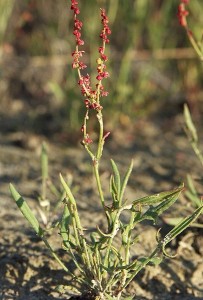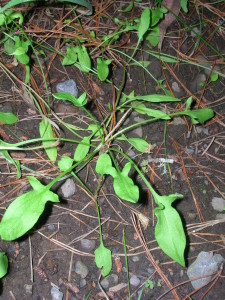
Sheep’s Sorrel(Rumex acetosella) is a common lawn weed. This is an edible plant that tastes great. It grows throughout the summer in many soil types. Sheep’s sorrel is native to Europe and Asian but has naturalized in the Northern United States. It has a uniquely shaped leaf that makes it easy to identify.
Edibility and Culinary Use
Sheep’s Sorrel contains oxalic acid so it has a slightly sour or tangy flavor. It can be eaten raw or cooked, the tangy taste is a great addition to salads, but it also tastes great eaten alone. Take a look at this Tangy Sorrel Salad Recipe. The roots can also be used in soups or salads. There are varieties of this plant grown commercially because its unique flavor is valued. This is one of those wild plants that tastes just as good if not better than most foods that are commonly purchased at the grocery store.
Health Benefits

Sheep’s Sorrel is known as a plant with many nutrients including: Vitamin C, B, D,E, K, beta carotene, magnesium, phosphorus, and potassium. It is known for its antibacterial properties, and has been used to treat bacterial infections including Staph, E.coli and Salmonella. It is also know as a treatment for urinary and kidney dysfunction. Sheep’s sorrel is believed to contain more antioxidants than most herbs and is used as a Native American cancer treatment called Essiac.
Cautions
Sheep’s Sorrel contains oxalic acid just like rhubarb, spinach and some other common vegetables. Oxalic acid aggravates conditions such as rheumatism, arthritis, gout, kidney stones or hyperacidity. So if your doctor has told you to avoid oxalic acid then avoid sheep’s Sorrel. Side effects of overdosing on Sheep’s Sorrel could include: headache, nausea, diarrhea, and tingling of the tongue.
Conclusion

Sheep’s Sorrel is a wild edible that can be found in many locations in the Northern US and tastes great, especially used in conjunction with other plants. It is easy to identify once you’ve seen the leaf shape, so next time you’re out foraging for wild edibles mix in some sheep’s sorrel, and notice the difference.
Many of our readers find that subscribing to Eat The Planet is the best way to make sure they don't miss any of our valuable information about wild edibles.
See our privacy policy for more information about ads on this site






